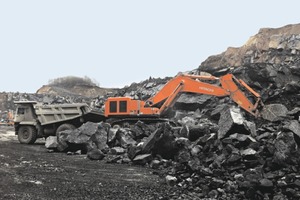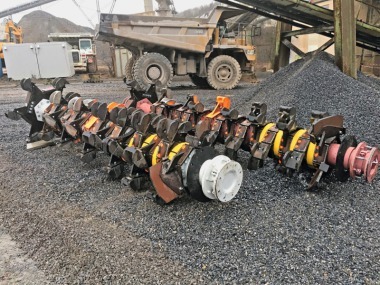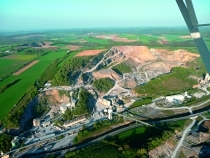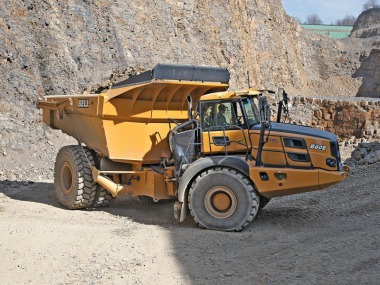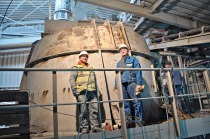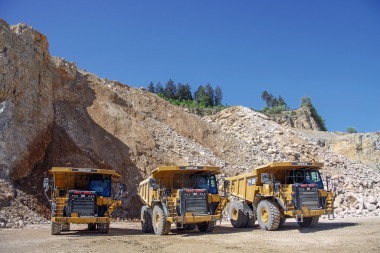70-tonne excavator with high fuel efficiency
A new hydraulic track excavator (Fig.) was recently added to the fleet of machines at the Warstein-based company Westkalk. The house-high, red colossus with a weight of 70 t is used at Suttrop Quarry. This excavator is used to load the dumper trucks with raw limestone, select overburden components out of the useful rock and crush oversized rocks. The excavator supplied by the Japanese company Hitachi can in the ideal case take up to 6 t raw limestone in its 4.5-m3 shovel – a VW Golf weighs 1.3 t. With regard to environmental aspects too, the modern machine is convincing: to meet the strict the EU exhaust gas standards, part of the exhaust gas is re-combusted, and as a result the emission of soot and nitrogen oxide content (NOx) is reduced. In addition, on Westkalk’s request, the 680-l hydraulic system has been filled with biodegradable oil. Particularly the electronic motor control and the modern hydraulic technology of the large-size excavator help improve productivity and fuel efficiency compared to conventional models – not least influenced the decision in favour of the € 0.5-mill. investment.
For the new addition from Japan, Westkalk is parting company as scheduled from one of its excavators with a service lifetime of six years or around 12 000 operating hours. The Warstein-based company also owns four 70-t and one 45-t excavators and a large wheel loader in its fleet of machines at its Warstein and Kallenhardt quarries: “The old excavator had already passed the zenith of availability and was therefore replaced as scheduled,” explains Dr. Guido Mausbach, Technical Manager at Westkalk. “When we make such an investment, we compare the capacity, the service and the price of machines from different manufacturers in advance as standard procedure. One exception is filling with biologically degradable hydraulic oil. For based purely on cost aspects, the excavator would have to be operated with conventional mineral oil. We deliberately opted for a different path.” Westkalk decided long ago that all new vehicles and machines should only be driven with bio-oil. In this way the company wants to make a small contribution to environmental protection.
The cost and effort involved in this, however, is enormous. For the Japanese firm Hitachi only uses mineral oil in the first filling of the hydraulic system. After the excavator had been sent in individual parts – dismantled into counterweight, substructure/superstructure, boom, shaft and bucket – via Amsterdam to Germany, the hydraulic system had to be refilled. At the Schmallenberg Service Centre, the fitters first put together the excavator. In the next step, the mineral oil was bled off and the complete system was flushed through with bio-oil. Only after the second filling with the biodegradable fuel, was the colossus ready for further transport to Warstein. “There is a clear target: the content of the tank must show less than 2 % mineral oil,” explains Mausbach. “It can take a few days before we get this result.” The bio-oil is also very sensitive to heat and water. For this reason, the excavator is equipped with a sub-flow filter. This additional device monitors the consistency of the oil and permanently filters this.
A driving licence is not necessary for the giant. “In principle, the excavator is easy to control. But a certain amount of experience is essential to work with it in the quarry,” says Mausbach. This applies particularly to the comminution of the large pieces of limestone with the help of the one-metre-wide and 5-t heavy steel ball. In this ball operation, the ball is picked up in the excavator bucket and dropped from a great height onto the block of rock. Mausbach: “If you don’t know what you’re doing, then it is easy to hit your own excavator with the steel ball. That can be expensive.”
The main area of application for the excavator, however, is loading of the raw limestone into the dumper trucks. Here it is less to do with the skill of the driver and more with the capacity of the excavator bucket. As the bucket of the Hitachi excavator is around 6 t, the set ten to eleven loading operations (loading cycles) are sufficient to completely fill a dumper with a 65-t payload. Dr. Mausbach explains: “The loading cycle is an important parameter for us. We use it to calculate the waiting time of the dumpers and the running times of the processing equipment. Everything depends on everything else. If the excavator takes too long, cost-intensive idle times in the processing plant result.”

